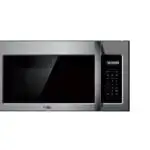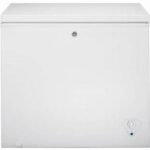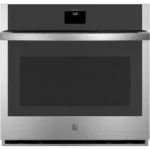

GE Appliances Washer
Whether you grew up with GE Appliances, or this is your first, we’re happy to have you in the family.We take pride in the craftsmanship, innovation and design that goes into every GE Appliances product, and we think you will too. Among other things, registration of your appliance ensures that we can deliver important product information and warranty details when you need them. Register your GE appliance now online. Helpful websites and phone numbers are available in the Consumer Support section of this Owner’s Manual. You may also mail in the pre-printed registration card included in the packing material.
WARNING
- To reduce the risk of death, fire, explosion, electric shock, or injury to persons when using your appliance, follow basic precautions, including the following:
- Read all instructions before using the appliance.
- Follow all fabric care instructions and warnings to prevent melting of garments or damage to the appliance.
- DO NOT add gasoline, dry-cleaning solvents, or other flammable or explosive substances to the wash water.
- These substances give off vapors that could ignite or explode.
- Under certain conditions, hydrogen gas may be produced in a hot-water system that has not been used for
- DO NOT wash or dry articles that have been previously cleaned in, washed in, soaked in or spotted with gasoline, dry-cleaning solvents, or other flammable or explosive substances, as they give off vapors that could ignite or explode.
- DO NOT allow children to play on or in this appliance. Close supervision of children is necessary when this appliance is used near children. Before the washer is removed from service or discarded, remove the door or lid. Failure to follow these instructions may result in death or injury to persons.
- DO NOT reach into the appliance if the tub or agitator is moving to prevent accidental entanglement.
- DO NOT install or store this appliance where it will be exposed to the weather.
- DO NOT tamper with controls, repair or replace any part of this appliance or attempt any servicing unless specifically recommended in the user maintenance instructions or in published user repair instructions that you understand and have the skills to carry out.
- DO NOT climb or stand on this unit.
- DO NOT operate this appliance if it is damaged, malfunctioning, partially disassembled, or has missing or broken parts including a damaged cord or plug.
- Unplug the appliance or turn off the circuit breaker before servicing. Pressing the Power pad DOES NOT disconnect power.
- See “ELECTRICAL REQUIREMENTS” located in the Installation Instructions for grounding instructions.
PROPER INSTALLATION
- This washer must be properly installed and located in accordance with the Installation Instructions before it is used. Ensure that the hot water hose is connected to the “H” valve and the cold water hose is connected to the “C”
valve. - Install or store where it will not be exposed to temperatures below freezing or exposed to the weather, which could cause permanent damage and invalidate the warranty.
- Properly ground washer to conform with all governing codes and ordinances. Follow details in the Installation Instructions.
- Ensure washer is properly leveled and washer legs are adjusted such that unit is stable.
- Optional drain hose extension recommended for discharging heights from 60” – 96”.
- GE Appliances strongly recommends the use of factory specified parts. A list of factory hoses available for purchase are listed. These hoses are manufactured and tested to meet GE Appliances specifications.
- GE Appliances strongly recommends the use of new water supply hoses. Hoses degrade over time and need to be replaced every 5 years to reduce the risk of hose failures and water damage.
WHEN NOT IN USE
Turn off water faucets to minimize leakage if a break or rupture should occur. Check the condition of the fill hoses; GE Appliances recommends changing the hoses every 5 years.
PARTS AND ACCESSORIES
Order online at GEApplianceparts.com today, 24 hours a day or by phone at 877.959.8688 during normal business hours. In Canada, visit your local GE Appliances parts distributor or call 800.661.1616 or GEAppliances.ca/en/products/parts-filters-accessories.
- WX14X10011 6 ft stainless steel washer hoses with 90° elbows; 2-pack
- WH49X316 Washer drain hose extension kit
- WX10X10011 Tide® Washing Machine Cleaner*
- PM7X2 Universal low profile washer floor tray
- GFA28KITN Stack Bracket Kit (to stack dryer on top)
- GFP1528S 28” width Pedestal with drawer – White
- GFP1528P 28” width Pedestal with drawer – Colors
Getting started
WARNING
To reduce the risk of fire, electric shock, or injury to persons, read the IMPORTANT SAFETY INFORMATION before operating this appliance. Throughout this manual, features and appearance may vary from your model.
Quick Start:
Step 1
Load clothes into your washer and close the door.
Step 2
If the screen is dark, press the Power pad or turn the knob to “wake up” the display.
Step 3
Turn the knob to select the desired cycle.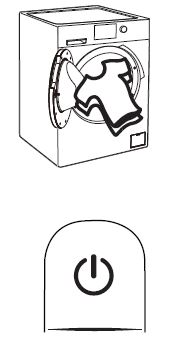
Step 4
Open the dispenser and add detergent, bleach and fabric softener, as desired. Models with SmartDispense™ only require that you select the SmartDispense pad once the tank has been filled.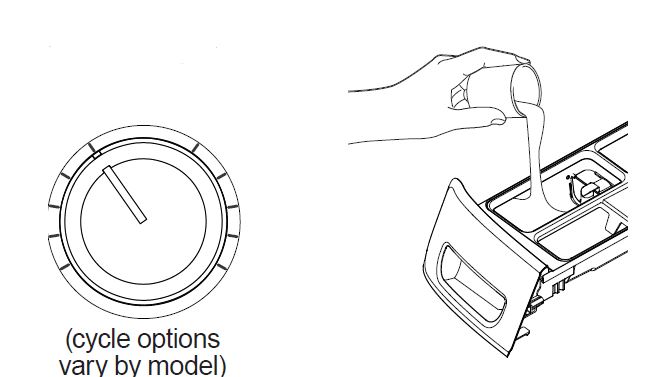
Step 5
Press Start to begin the wash cycle. The machine will weigh your clothes and add the proper amount of water. When the wash cycle is finished, the door will unlock.
Step 6
After the wash cycle is completed and the clothes unloaded, select ULTRA FRESH VENT™ to help eliminate the excess moisture in your washer so you can close the door.
Display and Status Lights (Features and appearance will vary)
The display shows the approximate time remaining until the end of the cycle and the washer cycle status (Fill, Wash, Rinse and Spin).
NOTE:
The cycle time is affected by how long it takes the washer to fill. This depends on the water pressure in your home. The “smart” timer “learns” the amount of time it takes to fill your washer and adjusts the total time accordingly.If an out-of-balance condition is detected by the washer, the Spin light will blink during the remaining portion of the cycle and will stay illuminated for a short time after cycle completion. When this occurs, the washer is taking actions to correct the out-of-balance condition and complete the cycle normally. In some cases, the washer may not be able to balance the load and spin up to full speed. If you notice the load is more wet than usual at the end of the cycle, redistribute the load evenly in the wash tub and run a Rinse & Spin cycle. In addition, the display will show:
In addition, the display will show:
| (WiFi) | Will allow your appliance to communicate with your smartphone for remote appliance monitoring, control and notifications. It stays lit whenever the washer is on and is connected. It will blink during the commissioning process or if it loses connection to the network. |
| Venting | Venting will blink to indicate that you can select the ULTRAFRESH VENT feature at the end of the cycle. It then stays illuminated once selected until venting is complete. |
| Control | The controls on the washer are locked when this icon is illuminated. You must press and hold the Control Lock pad to unlock the controls. |
| Door | This icon will illuminate while the door is locked and will blink while the washer is in the process of pausing and then unlocking. |
| Auto, More, Less
(on some models) |
The SmartDispense will automatically dose detergent according to the weight and soil level of the clothes. You can adjust this feature to dose 40% MORE or40% LESS detergent or turn it OFF to manually dose detergent. |
| Tank Low
(on some models) |
Will display when the SmartDispense tank needs to be re-filled. Typically, this first lights up when there are approximately 8 – 10 loads of detergent remaining. |
| Loads Left
(on some models) |
Displays the estimated number of wash loads left for the amount of detergent in the SmartDispense tank. |
Features and appearance will vary.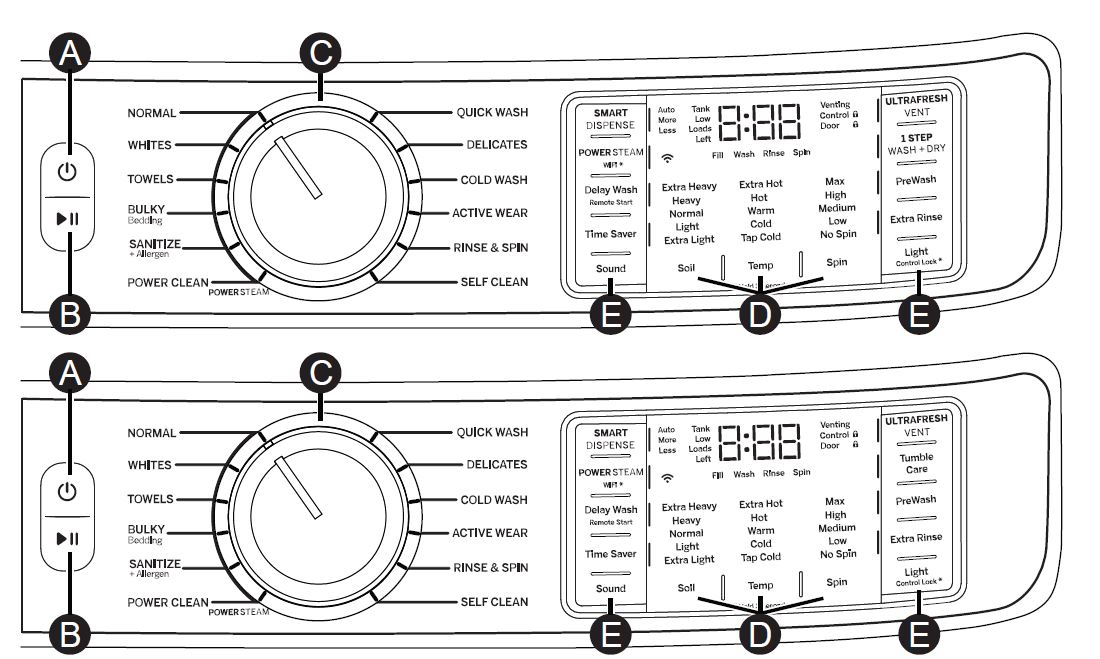
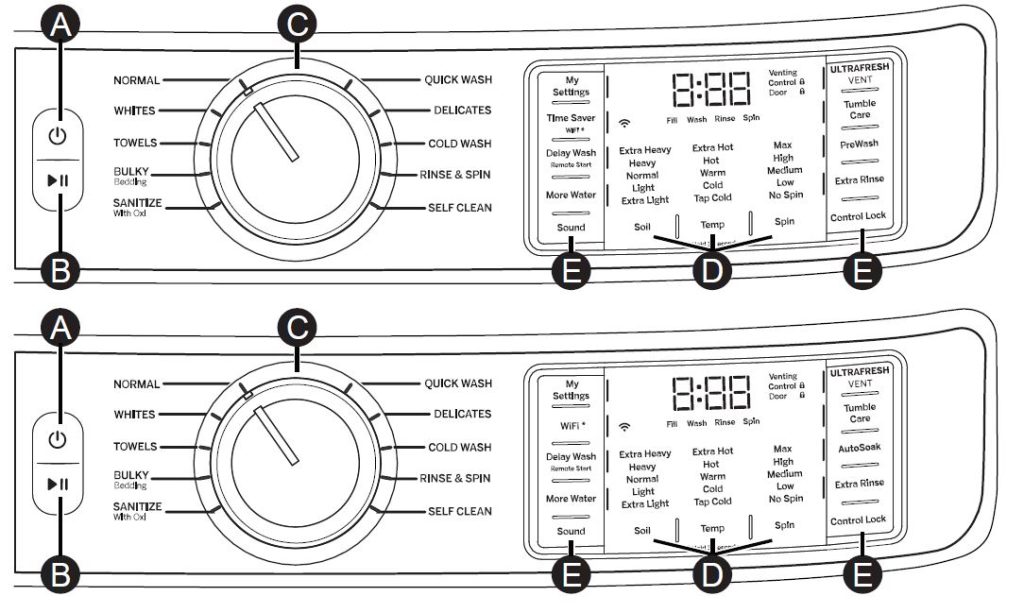
Power
Press to “wake up” the display. If the display is active, press to put the washer into standby “OFF” mode.
NOTE:
Pressing Power does not disconnect the appliance from the power supply.
Start and Pause
Press to start a wash cycle. If the washer is running, pressing it once will pause the washer and unlock the door. It will take a few seconds for the door to unlock after pressing Pause. Press again to restart the wash cycle.
NOTE:
If washer is paused and cycle is not restarted within 15 minutes, the current wash cycle will be cancelled.
NOTE:
The washer performs automatic system checks after pressing the Start pad. Water will flow in 45 seconds or less. You may hear the door lock and unlock and the pump activate before water flows.
Wash Cycles
The wash cycles are optimized for specific types of wash loads. The chart below will help you match the items to be washed with the best wash cycle settings. For optimal performance, select the cycle that most closely matches the items being washed. Selections and options shown in bold are the suggested settings for that cycle. Delay Wash/Remote Start is available on all cycles.
| Wash Cycle | Items to Wash | Soil Level | Wash Temp | Spin Selection | Options Available |
| Normal | Cycle for normal, | Extra Heavy | Extra Hot | Max | Prewash* or Autosoak* |
| regular, or typical use | Heavy | Hot | High | Power Steam* | |
| for washing up to a full | Normal | Warm | Medium | Time Saver* | |
| load of normally soiled | Light | Cold | Extra Rinse | ||
| cotton clothing. | Extra Light | Tap Cold | Tumble Care* or 1 Step Wash + Dry* | ||
| Whites | Whites and household | Extra Heavy | Extra Hot | Max | Prewash* or Autosoak* |
| linens. | Heavy | Hot | High | Power Steam* | |
| Normal | Warm | Medium | Time Saver* | ||
| Light | Cold | Low | More Water* | ||
| Extra Light | Tap Cold | Extra Rinse | |||
| Tumble Care* or 1 Step Wash + Dry* | |||||
| Towels | Towels, sheets, | Extra Heavy | Hot | Max | Prewash* or Autosoak* |
| pillowcases and dish | Heavy | Warm | High | Power Steam* | |
| rags. | Normal | Cold | Medium | Time Saver* | |
| Light | Tap Cold | Low | More Water* | ||
| Extra Light | Extra Rinse | ||||
| Tumble Care* or 1 Step Wash + Dry* | |||||
| Bulky | Large coats, bed | Extra Heavy | Hot | Max | Prewash* or Autosoak* |
| Bedding | spreads, mattress | Heavy | Warm | High | Power Steam* |
| covers, sleeping bags, | Normal | Cold | Medium | Time Saver* | |
| and similar large bulky | Light | Tap Cold | Low | More Water* | |
| items. | Extra Light | Extra Rinse | |||
| Tumble Care* or 1 Step Wash + Dry* | |||||
| Sanitize+ | Heavily soiled colorfast | Extra Heavy | Extra Hot | Max | Prewash |
| Allergen* | items with the need for | Heavy | High | Power Steam* | |
| sanitization. | Medium | Extra Rinse | |||
| Low | Tumble Care* or 1 Step Wash + Dry* | ||||
| Sanitize | Heavily soiled colorfast | Extra Heavy | Extra Hot | Max | Prewash* or Autosoak* |
| With Oxi* | items with the need for | Heavy | High | Extra Rinse | |
| sanitization. | Medium | Tumble Care | |||
| Low |
Some cycles and options may not be available on some models.
NOTE:
The SANITIZE + Allergen cycle’s water temperatures CANNOT be changed. This cycle utilizes elevated water temperature and a longer wash cycle to kill dust mites and reduce 99% of common bacteria from fabrics. A pump purge and extended rinse is incorporated for the purpose of removing contaminants and allergens, such as pet dander.The SANITIZE With Oxi cycle’s water temperatures CANNOT be changed. This cycle, when using an Oxi additive along with your detergent, is designed to remove 99% of bacteria found in home laundry. Measure the detergent and the Oxi products carefully. Using the amounts appropriate for a large heavily soiled load in a front load washer, follow the detergent and the Oxi product label instructions. The washer hot water supply connection must provide a minimum of 120°F to ensure the effectiveness of this cycle.Only the SANITIZE + Allergen and SANITIZE With Oxi cycles have been designed to meet the requirements of sanitizing effectiveness.49-3000217 Rev 2
Wash Cycles – Continued
The wash cycles are optimized for specific types of wash loads. The chart below will help you match the items to be washed with the best wash cycle settings. For optimal performance, select the cycle that most closely matches the items being washed. Selections and options shown in bold are the suggested settings for that cycle. Delay Wash/Remote Start is available on all cycles.
| Wash Cycle | Items to Wash | Soil Level | Wash Temp | Spin Selection | Options Available |
| Power Clean* | For heavily soiled items which require extra cleaning power. | Extra Heavy Heavy Normal | Extra Hot Hot Warm Cold
Tap Cold |
Max High Medium Low | Prewash Power Steam Extra Rinse
Tumble Care* or 1 Step Wash + Dry* |
| Quick Wash | Small loads of lightly soiled items that are needed in a hurry. | Normal Light
Extra Light |
Hot Warm Cold
Tap Cold |
Max High Medium Low | More Water* Extra Rinse
Tumble Care* or 1 Step Wash + Dry* |
| Delicates | Lingerie and special care fabrics with light soil. | Normal Light Extra Light | Warm Cold
Tap Cold |
Medium
Low No Spin |
Prewash* or Autosoak* Time Saver* More Water* Extra Rinse
Tumble Care* or 1 Step Wash + Dry* |
| Cold Wash | Cycle for normal, regular, or typical use for washing up to a full load of normally soiled cotton clothing using only cold water. | Extra Heavy Heavy Normal Light
Extra Light |
Cold
Tap Cold |
Max High Medium Low | Prewash* or Autosoak* More Water* Extra Rinse
Tumble Care* or 1 Step Wash + Dry* |
| Active Wear* | Medium to lightly soiled athletic wear items of technical or synthetic fabrics. | Extra Heavy Heavy Normal Light
Extra Light |
Warm Cold Tap Cold | Medium
Low No Spin |
Prewash Time Saver Extra Rinse
Tumble Care* or 1 Step Wash + Dry* |
| Rinse & Spin | For items that need only to be rinsed, use this cycle. | Max High Medium Low
No Spin |
More Water* Extra Rinse
Tumble Care* or 1 Step Wash + Dry* |
||
| Self Clean | Cleaning the basket of residue and odor. No clothes to be washed using this cycle. | Medium |
Some cycles and options may not be available on some models.
Settings
Individual settings for soil level (Level), water temperature (Temp) and spin speed (Spin) can be set from the minimum to maximum. In general, the higher up the column, the more energy will be used.
Soil
Changing the Soil level increases or decreases the wash time to remove different amounts of soil. To change the Soil level, press the Soil level pad until you have reached the desired setting. You can choose between Extra Light, Light, Normal, Heavy or Extra Heavy soil levels on most cycles.
temp
Adjust to select the proper water temperature for the wash cycle. The AutoSoak and PreWash rinse water is always cold to help reduce energy usage and reduce setting of stains and wrinkles.Follow the fabric manufacturer’s care label when selecting the wash temperature.To change the wash temperature, press the Temp pad until you have reached the desired setting. You can choose between Tap Cold, Cold, Warm, Hot or Extra Hot on most cycles. By design, to protect fabrics, not all wash temperatures are available for certain wash cycles. Extra Hot temperatures are enabled by the internal heater on models equipped with Steam capabilities.
NOTE:
The first 10 seconds of the wash fill is always cold. This feature assists in conditioning the fabric and preventing stains from setting on garments.
Spin
Adjusting the Spin speed changes the final spin speed of the cycles. Always follow the garment manufacturer’s care label when changing the Spin speed.To change the Spin speed, press the Spin speed pad until you have reached the desired setting. You can choose between No Spin, Low, Medium, High or Max. Higher spin speeds are not available on certain cycles, such as DELICATES and ACTIVE
WEAR
Higher spin speeds remove more water from the clothes and will help reduce dry time, but may also increase the possibility of setting wrinkles on some fabrics.
NOTE:
This washer features a dBT™ (Dynamic Balancing Technology) system. This patented onboard sensing technology enables real-time balancing of the spin cycle for each load, saving time and providing a quiet wash. This should lead to more consistent wash times and an overall reduction in noise and vibration. If the washer should experience any excessive noise, vibration or shaking, simply Pause the washer, open the door, and manually redistribute the load before restarting the cycle.
Options
SMARTDISPENSE™ (on some models)
When selected, this feature will automatically add detergent to the wash, eliminating the need to add detergent for each load. See the SmartDispense section for details.
MY SETTINGS (on some models)
To save your favorite settings, set the desired settings for wash cycle, soil level, spin speed and wash temp settings and hold down the My Settings pad for 3 seconds. A beep will sound to indicate the cycle has been saved. To use your custom settings, press the My Settings pad before washing a load.To change the saved settings, set the desired settings and hold down the My Settings pad for 3 seconds.
POWER STEAM (on some models)
Power Steam adds steam into the washer before the wash cycle begins to assist with loosening stains on the NORMAL, WHITES, TOWELS, BULKY Bedding, SANITIZE+Allergen and POWER CLEAN cycles.
To use:
- Press the Power pad to “wake up” the washer and select a wash cycle.
- Press the POWER STEAM pad to activate steam.
- Press the Start/Pause pad.
WiFi (may be a shared pad with other options)
Press and hold the WiFi* pad for 3 seconds to activate. See the WiFi Connect section for details on how to get stated with WiFi connection.
Delay Wash/Remote Start
You can delay the start of a wash cycle for up to 24 hours or remote start the washer by using the Delay Wash/Remote Start feature. Press to step by hours or hold to scroll the Delay Wash pad to set the amount of time you want to delay the start of the wash cycle. If you have connected your washer to WiFi, the first selection,“APP”, can be selected to enable remote starting of your washer from the GE Appliance Smartphone app. Or, if you select a delay time in hours, the machine will count down and start automatically following this period. Press the Start pad once you have configured the Delay Wash to the proper setting to enable this feature. To cancel this option, simply power off and power on the controls.
NOTE:
If you forget to fully close the door, a reminder signal will beep reminding you to do so.
NOTE:
If you open the door when the delay is counting down, the machine will enter the pause state. You must close the door and press Start again in order to restart the countdown.
Time Saver (on some models)
This option reduces the overall washer cycle time by optimizing the wash, rinse and spin actions and/or gently raising the wash temperature to get clothes cleaned faster. Option is available on NORMAL, WHITES, TOWELS, DELICATES, BULKY Bedding and ACTIVE WEAR cycles. Total wash time will vary based on cycle chosen and options selected.
To use:
- Turn power on and select a wash cycle which has Time Saver as an option.
- Press the Time Saver pad to reduce the overall wash time.
- Press the Start/Pause pad.
More Water (on some models)
This option adds approximately 3 gallons to the wash and rinse portions of the cycle. If the option is selected before the cycle starts, the water will be added from the beginning of the wash cycle and later to the rinse. If the option is selected during the wash portion, more water will be added at this point and later to the rinse. Likewise, if the More Water option is selected after the wash portion has completed, the washer will add more water to the rinse only. If wash and rinse have completed, the More Water pad will no longer be active.
ULTRAFRESH VENT System with ODORBLOCk
The ULTRA FRESH VENT System with OdorBlock was designed to eliminate excess moisture in the washer following a wash cycle to help prevent odors from developing. This washer was designed to drain water at the end of the cycle more effectively. Following the wash cycle, the user can then choose to leave the door open or select the ULTRA FRESH VENT feature to assist with drying out the gasket and other areas of the washer. The OdorBlock system features multiple components which are manufactured with Microban® antimicrobial technology.* Microban is a safe and effective antimicrobial technology that will last the life of your washer. For more information, please visit www.microban.com/geappliances.
ULTRA FRESH VENT is available after the wash cycle is complete and you have removed your cleaned laundry. Once the door is closed, a notification tune will play and the ULTRA FRESH VENT pad LED will blink. Upon pressing the pad, ULTRA FRESH VENT will begin.
To select ULTRA FRESH VENT at any other point, power on the washer, ensure a cycle is not actively running, and remove any garments from the basket, then press and release the ULTRA FRESH VENT pad so that the notification tune plays and the ULTRA FRESH VENT padLED begins to blink. Then press the ULTRA FRESH VENT pad again to start the feature.During the operation of ULTRA FRESH VENT the door will remain locked and the washer will intermittently spin at low speeds for up to 8 hours.If garments are detected in the basket during ULTRA FRESH VENT, the washer will instead run TUMBLE CARE or 1 STEP WASH + DRY, based on option available for your model.The ULTRA FRESH VENT feature may be cancelled at any time by pressing the POWER pad, turning the cycle knob, or pressing the ULTRA FRESH VENT pad. Microban® is a registered trademark of Microban International, Ltd.
1 STEP WASH + DRY (on some models)
This option is available on all cycles except Self Clean.The 1 STEP WASH + DRY is intended for small loads only. Use when clothes need to be washed, dried and ready to wear or finished the next morning. This feature will tumble clothes and introduce a constant stream of air into the washer compartment upon completion of select wash cycles. Although the drying portion is set to 8 hours, the clothes can be removed at any time by pressing Pause or Power to cancel the cycle.
Tumble Care (on some models)
Freshly tumbles your garments periodically for up to 8 hours after the wash cycle is complete to lessen the setting of wrinkles and creases when you are not able to move clothing to the dryer right away.At the end of the cycle, the display will scroll “END” and after ten minutes the Tumble Care will begin. It can be stopped at any time by pressing the Power pad.
PreWash (on some models)
Prewash is an extra wash before the main wash. Use it for heavily soiled clothes or for clothes with a care label that recommends prewashing before washing. Be sure to add liquid or powder high-efficiency detergent, or the proper wash additive to the prewash dispenser. Washers equipped with SmartDispense will automatically add the proper amount of detergent for prewash based on the load size.
PreWash must be selected prior to pressing Start
The PreWash feature will fill the washer (adding the prewash detergent), tumble the clothes, drain and spin. Then the washer will run the selected wash cycle.
NOTE:
In some special cycles, the prewash is selected automatically as the default. You can modify this selection at any time.
AutoSoak (on some models)
For soaking your garments prior to the wash cycle. This option begins with a brief tumble and then proceeds to soak the clothes with water and detergent for a specified period of time. Once complete, the cycle will continue automatically. AutoSoak must be selected prior to pressing the start pad. The AutoSoak time will add an additional 15 minutes, 30 minutes, 1 hour or 2 hours to the overall wash time. High-efficiency detergent from the main wash compartment in the dispenser is used for the AutoSoak period and main wash cycle.
Extra Rinse
This option allows for an extra rinse during a cycle to remove excess dirt and detergent from soiled loads. Press the Extra Rinse pad to select.
NOTE: On Rinse & Spin cycle, a drain and spin cycle can be achieved by pressing the Extra Rinse pad until the LED is no longer illuminated.
Light (on some models)
The basket light will turn on and remain on for 5 minutes when the door opens, Start/Pause pad is pressed, or by pressing the Light pad. The basket light can be turned off by pressing and holding the Light pad.
Sound
To change the loudness of the end of cycle signal and the press pad volume, press the Sound pad as many times as needed to reach the desired volume. There are four sound levels including off.
Control Lock (Light-Control Lock pad) (depending on model)
You can lock the controls to prevent any selections from being made. Or you can lock or unlock the controls after you have started a cycle. Children cannot accidentally start the washer by touching pads with this option selected. To lock/unlock the washer, press and hold the Control Lock/Light-Control Lock pad for 3 seconds. A sound is made to indicate the lock/unlock status. The control lock icon on the display will light up when it is on.
NOTE:
The Power pad can still be used when the machine is locked.
Dispenser Drawer
Slowly open the dispenser drawer by pulling it out until it stops. After adding laundry products, slowly close the dispenser drawer. Closing the drawer too quickly could result in early dispensing of the bleach, fabric softener or detergent. You may see water in the detergent, bleach and fabric softener compartments at the end of the cycle. This is a result of the flushing/siphoning action and is part of the normal operation of the washer.
SmartDispense™ (on some models)
When selected, this feature will automatically add detergent to the wash, eliminating the need to add detergent for each load.The detergent amount selection on the controlpanel will default to AUTO when first powering upthe washing machine. When AUTO is selected, the amount of detergent needed for each laundry load will automatically be determined based on the size of the load the machine senses.For AUTO, the washer will dispense approximately 1.5 oz of detergent for an 8 lb normal load. For other loads, it will adjust proportionally based on the size of load and garment type. If you select LESS, the amount of detergent will be reduced by 40%. This may be desired for higher concentrate detergents or if you have very soft water. For heavily soiled loads, you may want to select MORE to add 40% more detergent than the AUTO level.NOTE: Not all cycles will allow the use of the SmartDispense feature. If the light is not illuminated and pressing the SMART DISPENSE pad results in a beeping tone, then SmartDispense is not allowed for the cycle that has been selected. Detergent will need to be added directly to the detergent compartment for these cycles.Do NOT put detergent packets in the dispenser drawer.
NOTE: Use only liquid or powder HE detergents and additives in the dispenser drawer. Laundry detergent packets should only be added directly to the wash basket following the manufacturer’s directions.
If it is desired to manually select the amount of detergent for a given load, this can be done by pressing the SMART DISPENSE pad on the control panel to select detergent for a Small or Large load. Small will provide less detergent than average and Large will provide more detergent than average.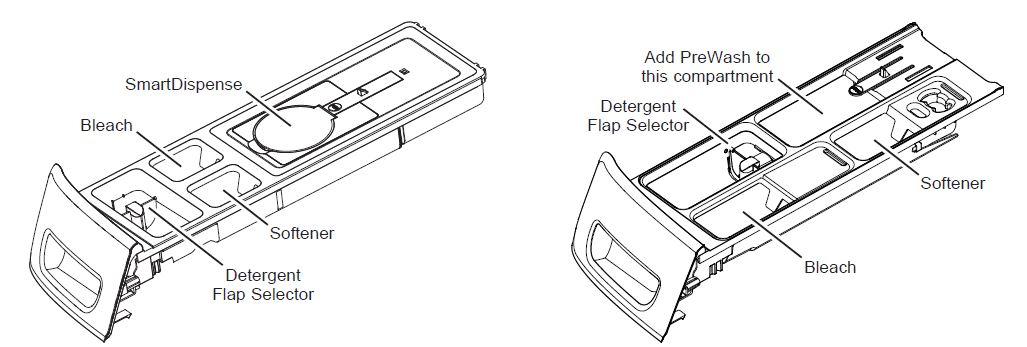
NOTE: If it is desired to manually add detergent for a load, that detergent will need to be added directly to the basket, and the SMART DISPENSE set to off for that particular load. The smart dispense feature can be disabled by pressing the SMART DISPENSE pad until off is selected.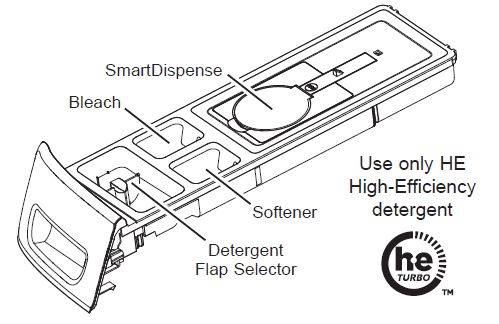
Detergent Compartment
Only use high-efficiency detergent in this washer. Do NOT fill high-efficiency detergent over the MAX line. Use detergent manufacturer’s recommended amount.
- Powder Detergent – Lift the flap up for powder detergent. This must be done to dissolve and flush detergent properly. Follow the detergent manufacturer’s instructions when measuring the amount of powder detergent to use.
- Liquid Detergent – Keep the flap down for liquid detergent. This retains the liquid detergent until it automatically flushes at the start of the wash cycle. Follow the detergent manufacturer’s instructions when measuring the amount of liquid detergent to use.
Liquid Bleach Compartment
If desired, measure out the recommended amount of liquid bleach, not to exceed 1/3 cup (80 ml) and pour into the compartment labeled “LIQUID BLEACH” marked with this symbol . It is recommended to use High-Efficiency (HE) bleach in this front-load washer.
Fabric Softener Compartment
If desired, pour the recommended amount of liquid fabric softener into the compartment labeled “FABRIC SOFTENER”.Use only liquid fabric softener in the dispenser. Dilute with water to the maximum fill line.Detergent usage may need to be adjusted for water temperature, water hardness, size and soil level of the load. Avoid using too much detergent in your washer as it can lead to oversudsing, detergent residue being left on the clothes, and could extend wash times.
Do not put clumped detergent in the dispenser. Clumped detergent can cause a leak. Do NOT put detergent packets in the dispenser drawer.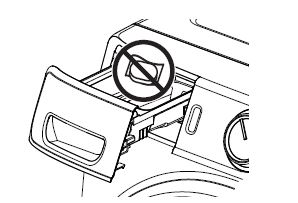
Do not exceed the maximum fill line. Overfilling can cause early dispensing of the bleach which could result in damaged clothes.
NOTE:
Do not use powdered bleach or laundry detergent/additive packets in the dispenser.Do not exceed the maximum fill line. Overfilling can cause early dispensing of the fabric softener, which could stain clothes.
NOTE:
Do not pour fabric softener directly on the wash load.
WiFi Connect (For customers in the United States only – on some models)
Your washer is GE Appliances WiFi Connect enabled.Visit geappliances.com/connect and enter your model number to show you the proper steps to connect your appliance.Please visit GEAppliances.com/connect to learn more about connected appliance features, to learn what connected appliance app’s will work with your smartphone. WiFi Connectivity: For assistance with the appliance or the ConnectPlus network connectivity, please call GE Appliances at 800.GE.CARES.
Loading
Always follow fabric manufacturer’s care label when laundering.
Sorting Wash Loads
Sort by color (whites, lights, colors), soil level, fabric type (sturdy cottons, easy care, delicates) and whether the fabric produces lint (terry cloth, chenille) or collects lint (velveteen, corduroy). Wash lint producers such as cotton towels and socks separate from lint collectors including synthetic garments and dress pants.
WARNING
- DO NOT wash fabrics soiled with flammable liquids or cleaning solvents. No washer can completely remove oil.
- DO NOT wash or dry anything that has been soaked in or spotted with any type of oil (including cooking oils).
- DO NOT reach into the washer until all moving parts have stopped.
- Doing so can result in death, explosion, fire or amputation.
Loading the Washer
The wash drum may be fully loaded with loosely added items.To add items after the washer has started, press Start/Pause and wait until the door is unlatched. The washer may take up to 30 seconds to unlock the door after pressing Start/Pause, depending on the machine conditions. Do not try to force open the door when it is locked. After the door unlocks, open gently. Add items, close the door and press Start/Pause to restart.
Loading Examples
| WORKWEAR | LINENS | MIXED LOAD | DELICATES* | QUICK WASH (2–3 GARMENTS) |
| 4 Jeans
5 Work Wear Shirts 3 Work Wear Pants |
2 Bath Sheets 10 Bath
Towels/ 12 Washcloths 7 Hand Towels/ 2 Terrycloth Bath Mats OR 2 Flat Queen-Sized Sheets 2 Fitted Queen-Sized Sheets 4 Pillowcases |
4 Pillowcases
2 Hand Towels 2 Flat Sheets/ 2 Fitted Sheets 2 Bath Towels/ 4 Washcloths OR 6 Shirts (Men’s or Women’s) 4 Pair Pants (Khakis or Twills) 5 T-shirts 7 Pairs of Boxers 4 Pairs of Shorts OR 6 T-shirts 4 Pairs of Sweatpants 4 Sweatshirts 2 Hoodies 7 Pairs of Socks |
7 Bras
7 panties 3 Slips 2 Camisole 4 Nightgowns *Using a nylon mesh bag for small items is recommended. |
2 Casual Wear Work Shirts
1 Pair Casual Wear Work Pants OR 3 Soccer Uniforms |
Care and cleaning
Water Supply Hoses
Hoses connecting washer to faucet should be replaced every 5 years.
Exterior
Immediately wipe off any spills. Wipe with damp cloth. Wipe or dust spills or washing compounds with a damp cloth. Washer control panel and finishes may be damaged by some laundry pretreatment and stain remover products. Apply these products away from the washer. The fabric may then be washed and dried normally. Damage to your washer caused by these products is not covered by your warranty. Do not hit surface with sharp objects.
Interior
Dry around the washer door opening, flexible gasket (including attached hoses) and door glass. These areas should always be clean to ensure a watertight seal. You will notice if you regularly use the ULTRAFRESH VENT System that this will not be required as often. It is recommended to rinse the washer at least once per month with 1 cup of bleach (or other commercially available product manufactured for this purpose, such as Tide® Washing Machine Cleaner) poured directly into the basket without clothes and using the Self Clean Cycle.
Self Clean
To clean the interior of the washer, select the SELF CLEAN feature on the control panel. This Self Clean cycle should be performed, at a minimum, onceper month or about every 30-40 wash cycles. This cycle will use more water, in addition to bleach, to control the rate at which soils and detergents may accumulate in your washer.
NOTE:
Read the instructions below completely before starting Self Clean cycle.
- Remove any garments or objects from the washer and ensure the washer basket is empty.
- Open the washer door and pour one cup or 250 ml of liquid bleach or other washing machine cleaner into the basket.
- Close the door and select the SELF CLEAN cycle. Push the Start pad.
- When the Self Clean cycle is working, the display will show the estimated cycle time remaining. The cycle will complete in about 90 minutes. Do not interrupt the cycle.
- After the cycle is complete, the washer will automatically start an ULTRAFRESH VENT operation so that the door can remain closed until the next time you use the washer.
- If for any reason the cycle needs to be interrupted, the door will not open immediately. Forcing open the door at this stage may cause water to flood. The door will open after the water is drained to a level where it would not flood the floor.
Self-Clean may be interrupted by pressing the Start pad in between cycles. A power outage in the house might also interrupt the cycle. When the power supply is back, the Self Clean cycle resumes where it had stopped. When interrupted, be sure to run a complete Self Clean cycle before using the washer. If the Power pad is pressed during Self Clean, the cycle will be lost.
IMPORTANT:- Run Self Clean with 1 Cup (250 ml) of bleach once a month.
- After the completion of a Self Clean cycle, the interior of your washer may have a bleach smell.
- It is recommended to run a RINSE & SPIN or a light color load after the Self Clean cycle.
Door Gasket
Open the washer door. Using both hands, press down the door gasket. Remove any foreign objects if found trapped inside the gasket. Make sure there is nothing blocking the holes behind the gasket.While holding down the door gasket, inspect the interior of the gasket by pulling it down with your fingers.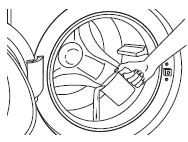
Remove any foreign objects if found trapped inside this gasket. Make sure there is nothing blocking the holes behind the gasket. When you are finished cleaning the door gasket, release it and the gasket will return to the operating position.
Dispenser Drawer Area
Detergent and fabric softener may build up in the dispenser drawer. Residue should be removed once or twice a month.
- • Remove the drawer by first pulling it out until it stops. Then reach back into the rear of the drawer cavity and press down firmly on the lock tab, pulling out the drawer.
• Rinse the drawer with hot water to remove traces of accumulated laundry products.
• To clean the drawer opening, use a small brush to clean the recess. Remove all residue from the upper and lower parts of the recess.
• Replace the dispenser drawer. - To reduce buildup in the Dispenser Drawer area:
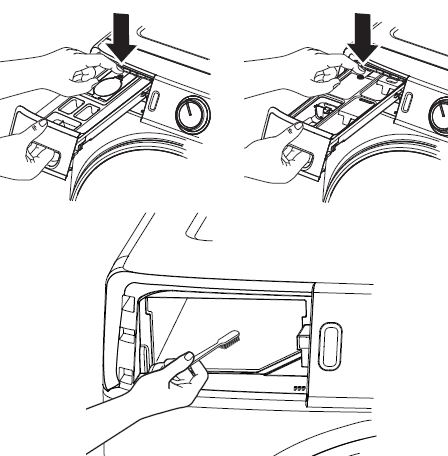
Pump Filter
Due to the nature of the front-load washer, it is sometimes possible for small articles to pass to the pump. The washer has a filter to capture lost items so they are not dumped to the drain. To retrieve lost items, clean out the pump filter.
- Using a small flathead screwdriver or coin, open the access door.
- Place a shallow pan or dish under the pump access door and towels on the floor in front of the washer to protect the floor. It is normal to catch about a cup of water when the filter is removed.
- Pull down the pour spout.
- Turn the pump filter counterclockwise and remove the filter slowly, controlling the flow of the draining water.
- Remove the filter and clean the debris from the filter.
- Replace the filter and turn clockwise. Tighten securely.
- Flip up the pour spout.
- Close the access door by hooking the bottom tabs first, then rotating the access door shut.
Moving and Storage
Ask the service technician to remove water from drain pump and hoses. Do not store the washer where it will be exposed to the weather. When moving the washer, the tub should be kept stationary by using the shipping bolts removed during installation. See Installation Instructions in this manual. If these parts are not available, they can be ordered by visiting our Website at GEApplianceparts.com or by calling GE Appliances at 877.959.8688. In Canada, visit your local GE Appliances parts distributor or call 800.661.1616 or GEAppliances.ca/en/products/parts-filters-accessories.
Long Vacations
Be sure water supply is shut off at faucets. Drain all water from hoses and water filter pump area if weather will be below freezing.
Installation Instructions
BEFORE YOU BEGIN
Read these instructions completely and carefully.
- Note to Installer – Be sure to leave these instructions with the Consumer.
- Note to Consumer – Keep these instructions for future reference.
- Skill level – Installation of this appliance requires basic mechanical and electrical skills.
- Completion time – 1-3 hours
- Proper installation is the responsibility of the installer.
- Product failure due to improper installation is not covered under the Warranty.
LOCATION OF YOUR WASHER
DO NOT Install the Washer:
- In an area exposed to dripping water or outside weather conditions. The ambient temperature should never be below 60°F (15.6°C) for proper washer operation.
- In an area where it will come in contact with curtains or drapes.
- On carpet. The floor MUST be a hard surface with To make sure the washer does not vibrate or move, you may have to reinforce the floor. plywood sheet solidly attached to existing floor covering.
MOBILE HOME INSTALLATION:
Installation must conform to Standard for Mobile Homes, ANSI A119.1 and National Mobile Home Construction and Safety Standards Act of 1974 (PL93-383).
TOOLS REQUIRED
PARTS SUPPLIED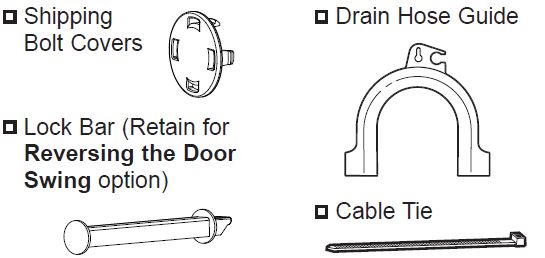
PARTS REQUIRED (Sold separately or included with the GFW510 model)
GE Appliances Parts and Accessories
Order on-line at GEApplianceparts.com today, 24 hours a day or by phone at 877.959.8688 during normal business hours. In Canada, visit your local GE Appliances parts distributor or call 800.661.1616 or GEAppliances.ca/en/products/parts-filters-accessories.Part Number Accessory WX14X10011 6 ft stainless steel washer hoses .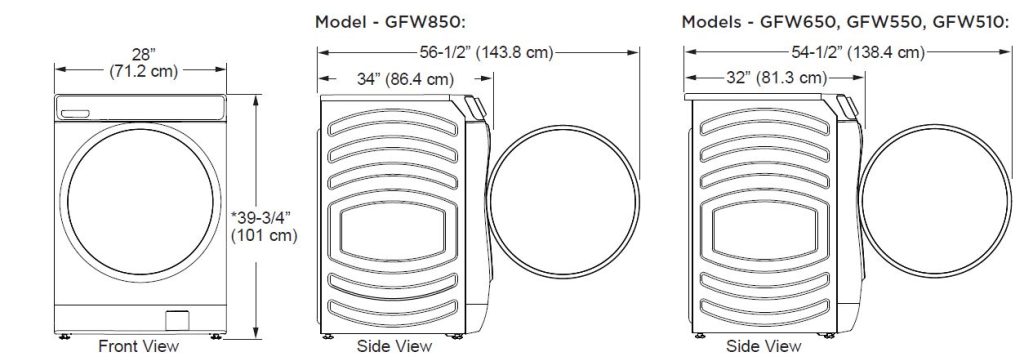
NOTE:
With leveling legs retracted: 39-3/4 (101 cm).
With leveling legs fully extended: 40-5/8 (103.1 cm).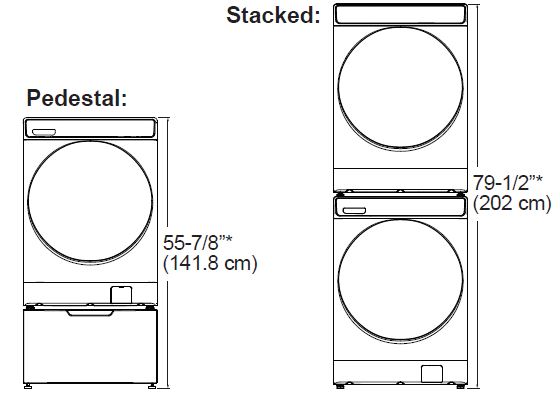
MINIMUM CLEARANCES
- Alcove or Closet
- Consideration must be given to provide adequate clearance for installation and service.
- Closet doors must be louvered or otherwise ventilated and have at least 60 square inches (387.1 cm2) of open area. If the closet contains both a washer and a dryer, doors must contain a minimum of 120 square inches (774.2 cm2) of open area.
- To enable 0” clearance on the back of the washer, you must use 90° elbow hoses. Otherwise you may require some additional clearance to avoid rubbing of the hoses against the back wall.
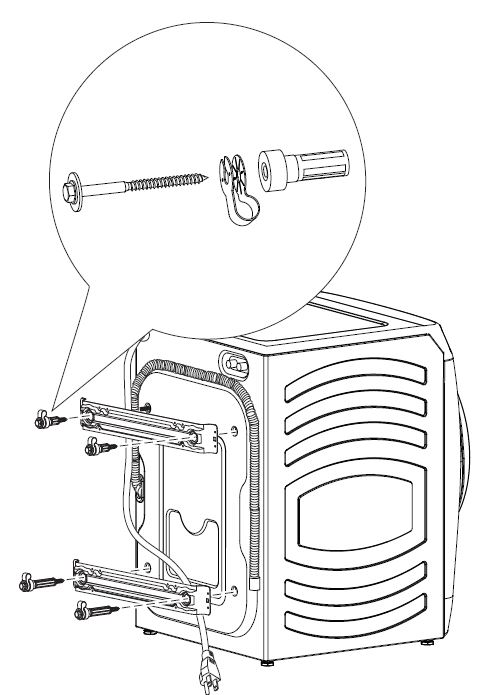
ACCESSORIES:
Order on-line at GEApplianceparts.com, 24 hours a day or by phone at 877.959.8688 during normal business hours.
| Part Number | Accessory |
| GFP1528SNWW | White Pedestal |
| GFP1528PNSN | Satin Nickel Pedestal |
| GFP1528PNRS | Royal Sapphire Pedestal |
| GFP1528PNDG | Diamond Gray Pedestal |
| GFA28KITN | Stacking Kit for Dryer over Washer |
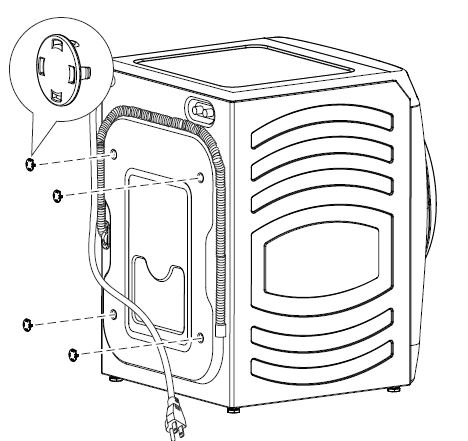
UNPACKING THE WASHER
- Cut and remove all packaging straps.
- While it is in the carton, carefully lay the washer on its side. DO NOT lay the washer on its front or back.
- Turn down the bottom flaps. Remove all base packaging including the styrofoam base.
- Carefully return the washer to an upright position and remove the carton by lifting it upward.
- Carefully move the washer to within 4 feet (122 cm) of the final location.
- Remove the following from the back side of the washer: 4 bolts
- NOTE: Do NOT remove the screw or clip holding the hose.
ELECTRICAL REQUIREMENTS
- Plug into a grounded 3-prong outlet.
- DO NOT remove ground prong.
- DO NOT use an adapter.
- DO NOT use an extension cord.
- Failure to follow these instructions can result in death, fire or electrical shock.
- CIRCUIT – Individual, properly polarized and grounded 15 or 20 amp circuit breaker or time-delay fuse.
- POWER SUPPLY – 2 wire plus ground, 120 Volt, single phase, 60 Hz, alternating current.
- Outlet Receptacle – Properly grounded 3-prong receptacle to be located so the power cord is accessible when the washer is in an installed position. If a 2-prong receptacle is present, it is the owner’s responsibility to have a licensed electrician replace it witha properly grounded 3-prong grounding type receptacle. Washer must be electrically grounded in accordance with local codes and ordinances, or in the absence of local codes, with latest edition of the NATIONAL ELECTRICAL CODE, ANSI/NFPA NO. 70 or CANADIAN ELECTRICAL CODE, CSA C22.1. Check with a licensed electrician if you are not sure that the washer is properly grounded.
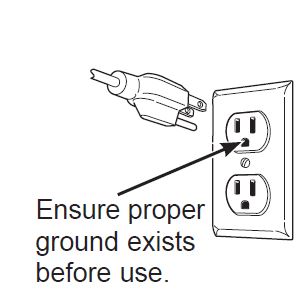
GROUNDING INSTRUCTIONS
This appliance must be grounded. In the event of malfunction or breakdown, grounding will reduce the risk of electric shock by providing a path of least resistance for electric current. This appliance is equipped with a cord having an equipment- grounding conductor and a grounding plug. The plug must be plugged into an appropriate outlet that is properly installed and grounded in accordance with all local codes and ordinances.If required by local codes, an external 18 gauge or larger copper ground wire (not provided) may be added. Attach to washer cabinet with a #10-16 x 1/2” sheet metal screw (available at any hardware store) to rear of washer.
Electrical Shock Hazard
Disconnect power supply before servicing.Replace all parts and panels before operating. Failure to do so can result in death or electrical shock. Certain internal parts are intentionally not grounded and may present a risk of electric shock only during servicing.Service personnel – DO NOT contact the following parts while the appliance is energized: water valve, drain pump, NTC, heater, door lock, inverter board, motor and MC board.
WATER SUPPLY REQUIREMENTS
Hot and cold water faucets MUST be installed within 42 inches (107 cm) of your washer’s water inlet. The faucets MUST be 3/4” (1.9 cm) garden hose-type so inlet hoses can be connected. Water pressure MUST be between 10 and 120 pounds per square inch. Your water department can advise you of your water pressure. The hot water temperature should be set to deliver water at 120° to 140°F (48°–60°C) to provide proper Automatic Temperature Control (ATC) performance.
NOTE: A water softener is recommended to reduce buildup of scale inside the steam generator if the home water supply is very hard.
DRAIN REQUIREMENTS
INSTALLING THE WASHER
- Run some water from the hot and cold faucets to flush the water lines and remove particles that might clog the inlet hose and water valve screens.
- Remove the inlet hoses from the packaging (whether supplied with the washer or sold separately).
- (90° elbow end) Ensure there is a rubber washer in the 90° elbow end of the HOT and COLD hoses. Reinstall the rubber washer into the hose fitting if it has fallen out during shipment. Carefully connect the inlet hose marked HOT to the outside “H” outlet of the water valve. Tighten by hand, then tighten another 2/3 turn with pliers. Carefully connect the other inlet hose to the inside “C” outlet of the water valve. Tighten by hand; then tighten another 2/3 turn with pliers. Do not cross-thread or over-tighten these connections.
- If inlet hose screen washers are not already inserted into the inlet hoses, install them by inserting into the free ends of the HOT and COLD inlet hoses with protruded side facing the faucet.
- Connect the inlet hose ends to the HOT and COLD water faucets tightly by hand, then tighten another 2/3 turn with pliers. Turn the water on and check for leaks.
- Carefully move the washer to its final location. Gently rock the washer into position. It is important not to damage the rubber leveling legs when moving your washer to its final location. Damaged legs
can increase washer vibration. It may be helpful to spray window cleaner on the floor to help move your washer into its final position.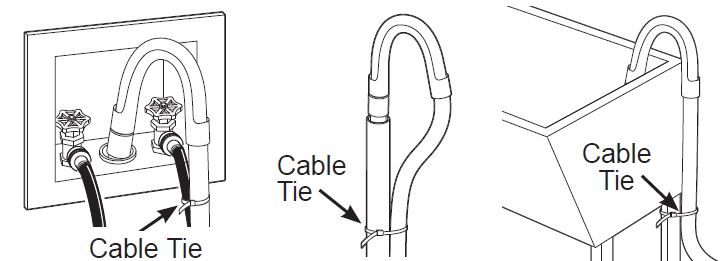
NOTE: To reduce vibration, ensure that all four rubber leveling legs are firmly touching the floor. Push and pull on the back right and then back left of your washer. NOTE: Do not use the dispenser drawer or door to lift the washer.
NOTE: If you are installing into a drain pan, you can use a 24-inch long 2×4 to lever the washer into place. - With the washer in its final position, place a level on top of the washer (if the washer is installed under a counter, the washer should not be able to rock). Adjust the front leveling legs up or down to ensure the washer is resting solidly. Turn the lock nuts on each leg up toward the base of the washer and snug with a wrench.
NOTE: Keep the leg extension at a minimum to prevent excessive vibration. The farther out the legs are extended, the more the washer will vibrate. If the floor is not level or is damaged, you may have to extend the rear leveling legs. - Attach U-shaped hose guide to the end of the drain hose. Place the hose in a laundry tub or standpipe and secure it with the cable tie provided in the enclosure package.
- Plug the power cord into a grounded outlet. NOTE: Check to be sure the power is off at the circuit breaker/fuse box before plugging the power cord into an outlet.
- Turn on the power at the circuit breaker/fuse box.
- Read the rest of this Owner’s Manual. It contains valuable and helpful information that will save you time and money..
- Before starting the washer, check to make sure: Main power is turned on.
REPLACEMENT PARTS
If replacement parts are needed for your washer, they can be ordered in the United States by visiting our Website at GEApplianceparts.com or by calling GE Appliances at 877.959.8688. In Canada, visit GEAppliances.ca/en/products/parts-filters-accessories or call 800.661.1616.
REVERSING THE DOOR SWING (Optional)
Unplug the appliance or turn off the circuit breaker before servicing. Pressing the Power pad DOES NOT disconnect power. Certain internal parts are intentionally not grounded and may present a risk of electric shock only during servicing.
Service personnel – DO NOT contact the following parts while the appliance is energized: water valve, drain pump, NTC, heater, door lock, inverter board, motor and MC board.
REMOVE THE DOOR ASSEMBLY
- Open the washer door.
- While supporting the door, remove the 6 screws from the hinge in the washer face.
- Lift the door assembly to remove it from the washer face and set it on a protective surface.
IMPORTANT NOTES
- Handle parts carefully to avoid scratching paint.
- Provide a non-scratching work surface for the door.
- Set screws down by their related parts to avoid using them in the wrong places.
- Once you begin, do not move the cabinet until door-swing reversal is completed.
- These instructions are for changing the hinges from the left side to the right side—if you ever want to switch them back to the right side, follow these same instructions and reverse all references to the left and right.
- Remove the 3 screws from the hinge cover and remove the cover.
- Remove the 6 screws from the hinge and remove the hinge from the door.
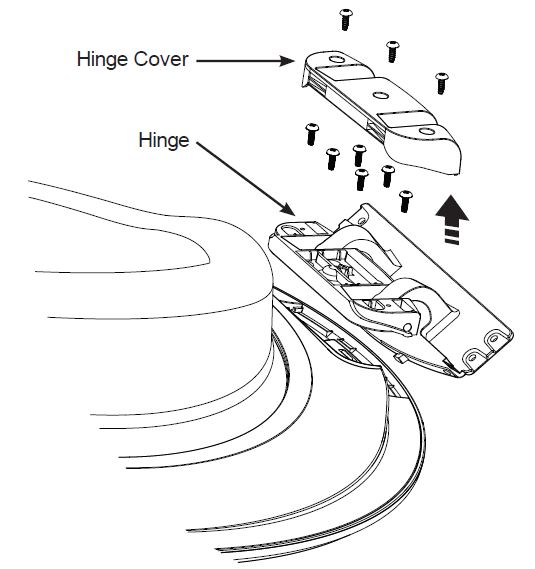
- Remove the 2 screws from the striker. Rotate the striker 180° and reinstall the striker with its screws.
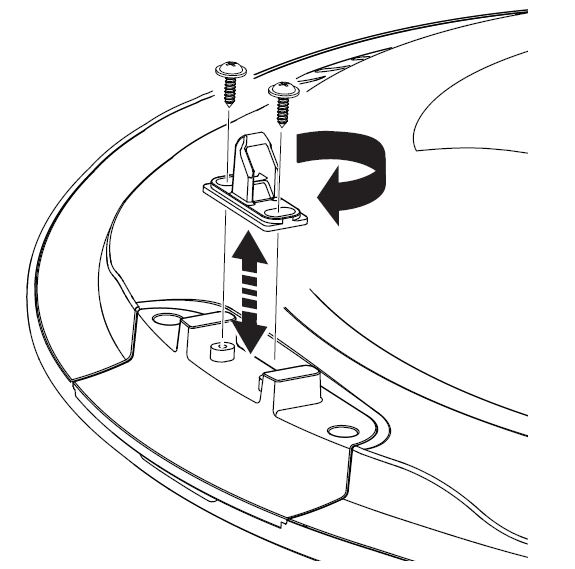
- Remove the 2 screws from the striker assembly and remove the assembly by pulling it toward the center, pushing it up and pulling it out.
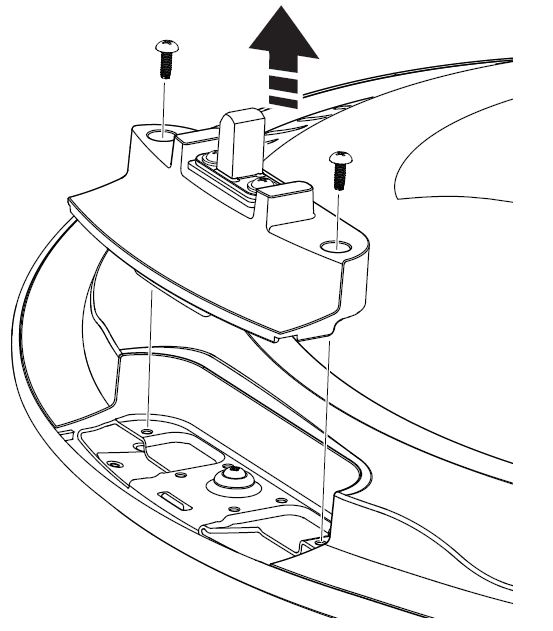
- Rotate the striker assembly and replace it on the opposite side with its screws.
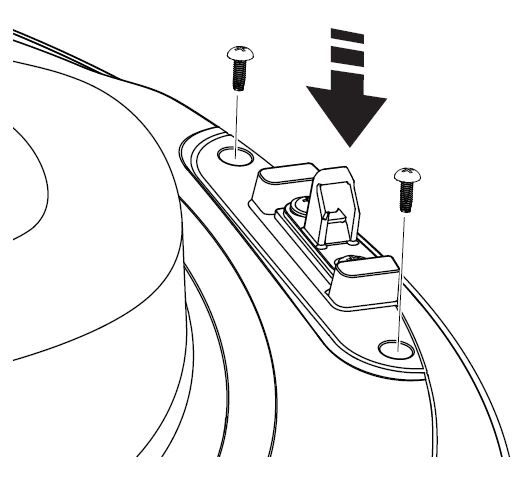
- Rotate the door hinge and replace it on the opposite side with its screws.
- Rotate the door hinge cover and replace it on the opposite side with its screws.
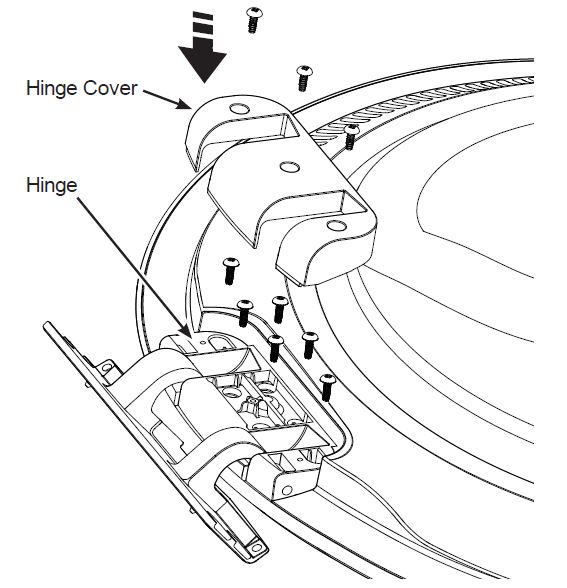
- Using your fingers, pry the terminal holder from the washer face.
- Disconnect the pin connector.
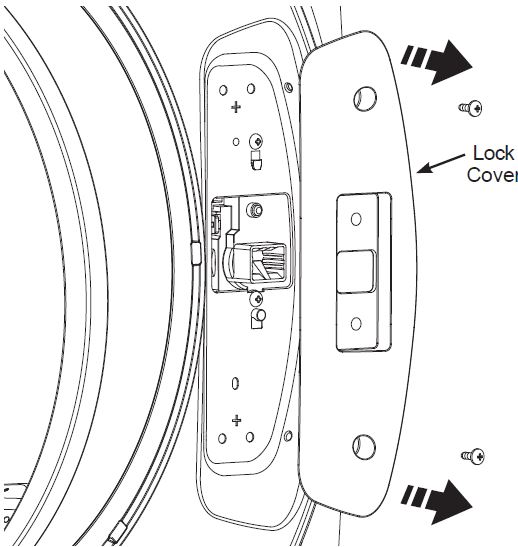
- Remove the 2 screws from the lock cover and remove it from the washer face.
- Insert the provided lock bar into the lock mechanism in the washer face. Remove the lock assembly by removing its two screws, using the lock bar to lift it up to unhook, tilting and pulling it out of the washer face. Disconnect its pin connector by unsnapping its locks.
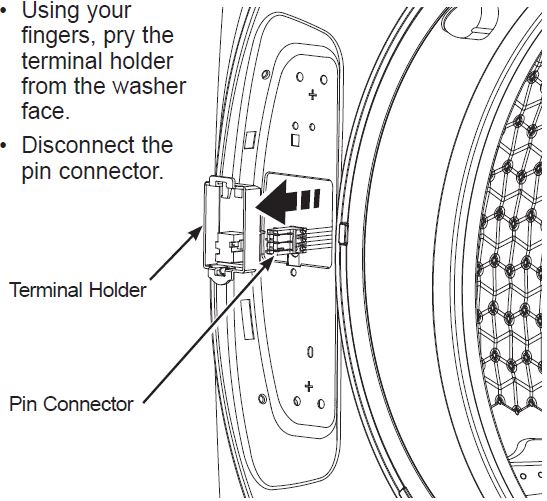
- Do NOT rotate lock assembly. Move it to the opposite side of the washer and connect the pin connector making sure it is fully snap locked together. Tilt and insert the lock assembly into the washer face, lift it up and latch its hook into its window. Replace its screws. Remove the lock bar from the assembly and retain for future use.
- Install the lock cover over the lock assembly, making sure the locating post fits into the locating hole and that the lock switch operates freely. Replace its screws.
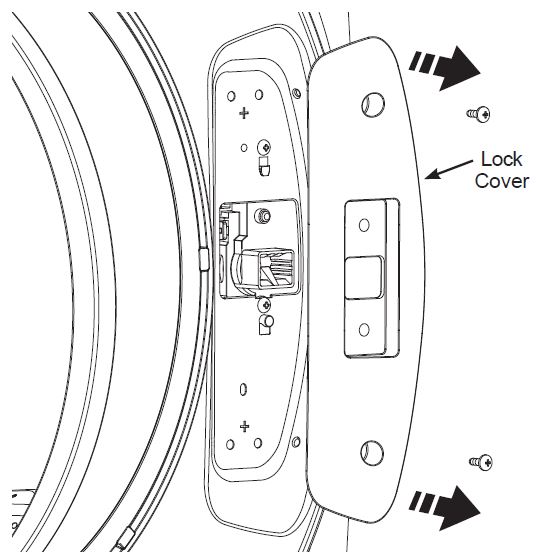
- Reconnect the pin connector and press the terminal holder back into the washer face on the opposite side.
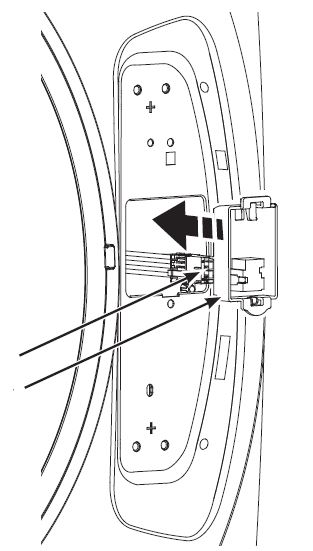
- Lift the door assembly into place and secure it onto the washer face with its 6 screws.
- Close the washer door.
NOTE: Make sure the door opens and closes correctly. If not, repeat all steps making sure all parts and screws are securely seated. - Connect power cord and turn on the breaker.
- Run the washer through a complete cycle to verify proper operation.
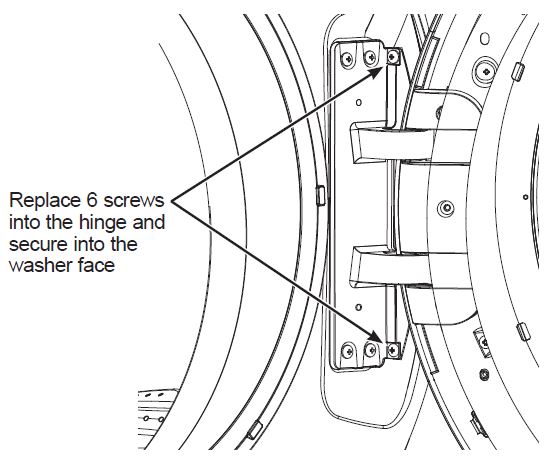
Troubleshooting
| Problem | Possible Cause | What To Do |
| Grayed or yellowed clothes | Not enough detergent | Use correct amount of detergent. |
| Not using HE (high efficiency) detergent | Use only HE detergent. | |
| Hard water | Use hottest water safe for fabric. | |
| Use a water conditioner like Calgon brand or install a water softener. | ||
| Water is not hot enough | Make sure water heater is delivering water at 120°–140°F (48°–60°C). | |
| Detergent is not dissolving | Try a liquid HE detergent. | |
| Dye transfer | Sort clothes by color. If fabric label states wash separately, unstable dyes may be indicated. | |
| Colored spots | Incorrect use of fabric softener | Check fabric softener package for instructions and follow directions for using dispenser. |
| Dye transfer | Sort whites or lightly colored items from dark colors. | |
| Promptly remove wash load from washer. | ||
| Water temperature is incorrect | Water supply is improperly connected | Make sure hoses are connected to correct faucets. |
| House water heater is not set properly | Make sure house water heater is delivering water at 120°– 140°F (48°–60°C). | |
| Bad odor inside your Washer | Washer unused for a long time, not using
recommended quality of HE detergent or used too much detergent |
Regularly use ULTRAFRESH VENT between uses. |
| In case of strong odor, you may need to run the Self Clean
cycle more than once. |
||
| Use only the amount of detergent recommended or adjust
SmartDispense to LOW. |
||
| Use only HE (high efficiency) detergent. | ||
| Always remove wet items from the washer promptly after it stops running or use 1 Step Wash + Dry or Tumble Care. | ||
| If you choose to not use the ULTRAFRESH VENT System, leave the door slightly open for the washer to air dry. Close supervision is necessary if this appliance is used by or near children. Do not allow children to play on or in this appliance. | ||
| Detergent leak | This is normal | It is normal operation to see detergent leak on door gasket about 20 seconds after filling the dispenser. |
| Improper dispensing of softener or bleach | Dispenser clogged | Monthly clean the dispenser drawer to remove buildup of chemicals. |
| Softener or bleach is filled above the max line | Make sure to have the correct amount of softener. | |
| Dispenser drawer not dispensing properly | Laundry detergent packet placed in dispenser drawer | Laundry detergent packets should not be used in the dispenser. They should only be added directly to the wash tub following the manufacturer’s directions. |
| Pump running while washer is not in use | Clog in sump drain | This is normal. Drain sump is detecting an undesired water fill level from a potential open faucet. Shut off water valve and inspect water valve for blockage. |
| Problem | Possible Cause | What To Do |
| Washer pauses or has to be restarted, or washer door is locked and will not open | Pump filter may be clogged | See the Care and Cleaning section on how to clean the
Pump Filter. |
| Door unlocks or press Start and machine doesn’t operate | This is normal | Front-load washers start up differently than top-load washers, and it takes several seconds to check the system. The door will lock and unlock. |
| Incorrect operation | Simply open and close the door firmly; then press Start. | |
| Water does not enter washer or enters slowly | Automatic self system checks | After Start is pressed, the washer does several system checks. Water will flow several seconds after Start is pressed. |
| Water valve screens are stopped up | Turn off the water source and remove the water connection hoses from the upper back of the washer. Use a brush or toothpick to clean the screens in the machine. Reconnect the hoses and turn the water back on. | |
| Inlet hose screen washers are stopped up | Turn off the water source and remove the inlet hoses from the wall faucets. Use a brush or toothpick to clean the screen washers in the end of the hoses. Reconnect the hoses and turn the water back on. | |
| Pump filter may be clogged | See the Care and Cleaning section on how to clean the
Pump Filter. |
|
| Fill hoses may be kinked | Check that fill hoses are not kinked or clogged. | |
| Water supply is turned off | Turn on both hot and cold faucets fully. | |
| Energy efficiency | This is an energy-efficient washer. As a result, the temperature settings for this washer may be different than for a non-energy- efficient washer. | |
| Insufficient water supply | Make sure that the water supply is turned on. Make sure that the water faucets are turned to their completely open position. | |
| The washer door is open | The washer door must be closed for all washer cycle operations. If the door is opened during the washer operation, all functions will stop, including water filling. | |
| Incorrect fill hose connection | Make sure that the fill hoses connect the hot water supply to the hot inlet on the washer and the cold water supply to the cold inlet on the washer (hot to hot, cold to cold). | |
| Wrinkling | Improper sorting | Avoid mixing heavy items (like work clothes) with light items (like blouses). |
| Overloading | Load your washer so clothes have enough room to move freely. | |
| Incorrect wash cycle | Match cycle selection to the type of fabric you are washing (especially for easy care loads). | |
| Repeated washing in water that is too hot | Wash in warm or cold water. |
GE Appliances Washer Limited Warranty
All warranty service is provided by our Factory Service Centers, or an authorized Customer Care® technician. To schedule service online, visit us at GEAppliances.com/service, or call GE Appliances at 800.GE.CARES (800.432.2737). Please have your serial number and your model number available when calling for service.Servicing your appliance may require the use of the onboard data port for diagnostics. This gives a GE Appliances factory service technician the ability to quickly diagnose any issues with your appliance and helps GE Appliances improve its products by providing GE Appliances with information on your appliance. If you do not want your appliance data to be sent to GE Appliances, please advise your technician not to submit the data to GE Appliances at the time of service.
| For the period of: | We will replace: |
| One year
From the date of the original purchase |
Any part of the washer which fails due to a defect in materials or workmanship. During this limited one-year warranty, we will also provide, free of charge, all labor and related service to replace the defective part. |
| Ten years
From the date of the original purchase |
The motor, if it should fail due to a defect in materials or workmanship. During this additional nine-year limited warranty, you will be responsible for any labor and related service costs. |
What is not covered:
- Service trips to your home to teach you how to use the product.
- Improper installation, delivery or maintenance.
- Failure of the product if it is abused, misused, or used for other than the intended purpose or used commercially.
- Replacement of house fuses or resetting of circuit breakers.
- Products which are not defective or broken, or which
- Damage to the product caused by accident, fire, floods or acts of God.
- Incidental or consequential damage caused by possible defects with this appliance.
- Defects or damage due to operation in freezing temperatures.
- Damage caused after delivery.
- Product not accessible to provide required service.
EXCLUSION OF IMPLIED WARRANTIES
Your sole and exclusive remedy is product repair as provided in this Limited Warranty. Any implied warranties, including the implied warranties of merchantability or fitness for a particular purpose, are limited to one year or the shortest period allowed by law.
In the United States:
This limited warranty is extended to the original purchaser and any succeeding owner for products purchased for home use within the USA. If the product is located in an area where service by a GE Appliances Authorized Servicer is not available, you may be responsible for a trip charge or you may be required to bring the product to an Authorized GE Appliances Service location for service. In Alaska, the limited warranty excludes the cost of shipping or service calls to your home.
Some states do not allow the exclusion or limitation of incidental or consequential damages. This limited warranty gives you specific legal rights, and you may also have other rights which vary from state to state. To know what your legal rights are, consult your local or state consumer affairs office or your state’s Attorney General. Warrantor: GE Appliances, a Haier Company, Louisville, KY 40225
Consumer Support
GE Appliances Website
Have a question or need assistance with your appliance? Try the GE Appliances Website 24 hours a day, any day of the year! You can also shop for more great GE Appliances products and take advantage of all our on-line support services designed for your convenience. In the US: GEAppliances.com. In Canada: GEAppliances.ca.
GE Appliances Website
Have a question or need assistance with your appliance? Try the GE Appliances Website 24 hours a day, any day of the year! You can also shop for more great GE Appliances products and take advantage of all our on-line support services designed for your convenience. In the US: GEAppliances.com. In Canada: GEAppliances.ca.
Remote Connectivity
For assistance with wireless network connectivity (for models with remote enable), in the US visit our website at connected-home-smart-appliances/ or call 800.220.6899. In Canada: http://www.geappliances.ca/en/news-and-promotions/what-is-hot/wifi-connect/.
FAQS
How do I know if my appliance has been recalled?
Please visit our website at www.geappliances.com and click on the “Product Recalls” link to see if your appliance has been recalled. If it has been recalled, we will provide you with the steps to take to have your appliance repaired. If you have any questions, please call our Consumer Assistance Center toll-free at 1-800-432-2737. GE Appliances Washer Instructions Manual
Is GE a good brand for washers?
GE is considered to be one of the most reliable brands on the market. With proper installation, level floors, and ideal water hardness conditions, you should be able to get up to 10 years of use out of a GE washer.
Why is GE washer not working?
If the light on the washer doesn’t turn on, try restarting the washing machine by pressing the Start/Pause Wash button. The light should come on again. If it still doesn’t turn on, check if the outlet’s power is on. If it is, unplug and plug in the washer to a different outlet.
Which is the most reliable washing machine brand?
Whirlpool, LG, and Samsung are the most reliable brands of washers. Yale Appliance found that less than 7% of the sales of these units required servicing. J.D. Power also ranks Samsung and LG as the highest-ranking manufacturers in customer satisfaction.
Does a GE washer have a reset button?
To reset the electronic controls on your washer, shut off the circuit breaker or fuse to the washer or unplug the washer for 2 minutes. For models that have a timer control knob, turn the knob around and back to any position other than final spin for the interrupted cycle. Then, restore power.
Does unplugging a washer reset it?
On a machine without a reset button, unplugging the washer and then plugging it back in often serves as the means to reset it. Although not usually a button, programmable washing machines might have a reset function or position to clear a program problem.
Why is my GE washer stuck on sensing?
A GE washer stuck on sensing can be one of three problems depending on the exact model. It is either a clog in the drain pump, a failed drain pump, or faulty transmission. The first problem is an easy DIY fix, the last two issues will require the help of a service tech.
Are GE Appliances good quality?
GE refrigerators are known for their reliability, good quality, and innovative features, which is reflected in all their models on the market. Across top-freezer, bottom-freezer, side-by-side, and French Door models, GE fridges have great longevity, and all have at least a one-year company warranty.
Who makes GE washers now?
While GE’s appliance division is now owned by the Chinese company Haier, laundry appliances are still made at GE headquarters in Louisville, Kentucky. Now offering the utmost in technological advances, the 128-year old General Electric Company is a leader in American made washer and dryer brands.
What is the difference between an agitator and impeller?
Washing machines with agitators use a central post that twists back and forth, rubbing against clothes to help break apart stains. In contrast, washing machines with impellers use a low-profile cone or disc that spins/rotates to rub clothes against each other to get them clean.
Where is GE front load washer made?
GE has added two new assembly lines to its plant in Appliance Park and for the first time will manufacture front-loading washing machines and their matching dryers in the U.S. The folks in Louisville, Kentucky are happy because the move creates 200 new jobs.
Are front load or top load washers better?
Front load washers are considered superior at cleaning clothes with less water and less wear on your fabrics. Top load washers clean faster and are slightly more ergonomic, so it may come down to the monetary value.
Which washers last the longest?
As far as washing machines go, there are few which last as long as Speed Queen washing machines. The top-end machines are rated to last for 25 years or 10,400 loads. Speed Queen also offers between 3-7 year warranties.
Is GE owned by China?
GE Appliances: Now, despite rumors recently pushed in viral social media posts, General Electric has not been sold itself to Chinese interests. But GE’s appliance division was indeed sold, in 2016, to the Chinese tech company Haier.
What is better Maytag or Whirlpool?
Both brands will deliver a durable product and a quality clean. Maytag washing machines provide a greater value and display of features compared to Whirlpool, whereas with Whirlpool, you will find a greater selection of top-load and front-load products with a wider range of price points.
Is GE a good brand for washers?
GE is considered to be one of the most reliable brands on the market. With proper installation, level floors, and ideal water hardness conditions, you should be able to get up to 10 years of use out of a GE washer.
